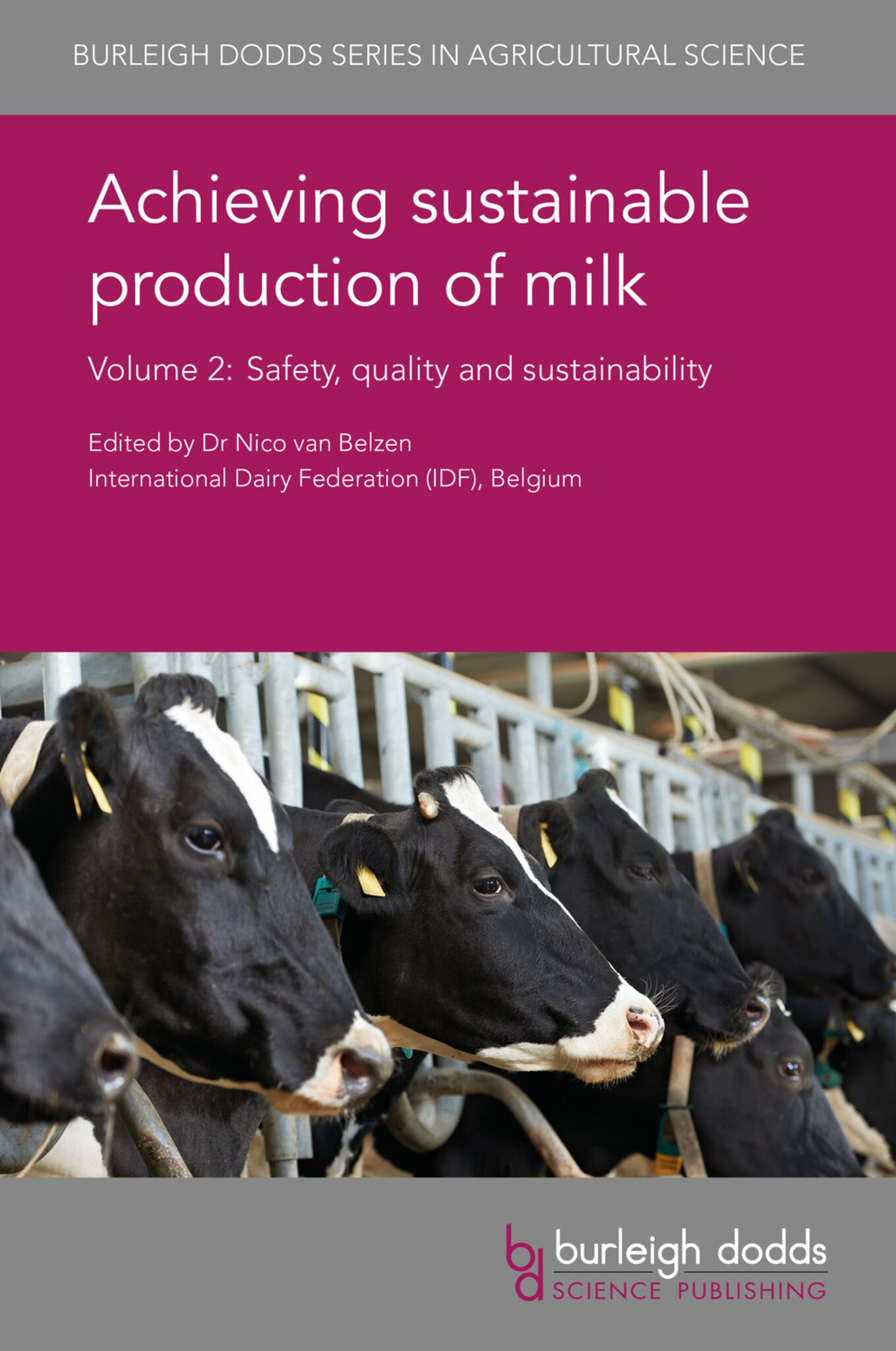We're sorry. An error has occurred
Please cancel or retry.
Achieving sustainable production of milk Volume 2

Some error occured while loading the Quick View. Please close the Quick View and try reloading the page.
Couldn't load pickup availability
- Format:
-
06 June 2017

- Summarises current research on pathogenic risks affecting milk and ways they can be controlled on the farm;
- Reviews ways of measuring and reducing the environmental impact of dairy farming such as better grassland management;
- Assesses the wider role of dairy farming and how it can be improved in the developing world

TECHNOLOGY & ENGINEERING / Agriculture / Sustainable Agriculture, Dairy farming, TECHNOLOGY & ENGINEERING / Agriculture / Animal Husbandry, Agricultural engineering and machinery, Sustainable agriculture, Organic farming

”All three volumes of Achieving sustainable production of milk should be considered as a whole…Over more than 1200 pages, the authors review all fields of milk production, beginning with milk composition, genetics and breeding, safety and milk quality, sustainability of milk production as well as dairy herd management, health, welfare and nutrition of dairy. All three volumes could be considered a standard reference for graduate students in the fields of dairy science and veterinary medicine, animal and dairy scientists at universities and other research centres, and also those in governments and companies involved or working in the field of milk production.”
Animal Feed Science and Technology
Part 1 Ensuring the safety and quality of milk on the farm1.Pathogens affecting raw milk from cows: Claire Verraes, Sabine Cardoen and Wendie Claeys, Federal Agency for the Safety of the Food Chain, Belgium; and Lieve Herman, Institute for Agricultural and Fisheries Research, Belgium;
2.Detecting pathogens in milk on dairy farms: key issues for developing countries: Delia Grace, Silvia Alonso, Johanna Lindahl, Sara Ahlberg and Ram Pratim Deka, International Livestock Research Institute (ILRI), Kenya;
3.Mastitis, milk quality and yield: P. Moroni, Cornell University, USA and University of Milano, Italy; F. Welcome, Cornell University, USA; and M. F. Addis, Porto Conte Ricerche, Italy;
4.Chemical contaminants in milk: Bernadette O’Brien and Kieran Jordan, Teagasc, Ireland;
5.Detecting and preventing contamination of dairy cattle feed: Delia Grace, International Livestock Research Institute (ILRI), Kenya; Johanna Lindahl, International Livestock Research Institute (ILRI), Kenya and Swedish University of Agricultural Sciences, Sweden; Erastus Kang’ethe, University of Nairobi, Kenya; and Jagger Harvey, Biosciences Eastern and Central Africa Hub, International Livestock Research Institute (ILRI), Kenya; Feed the Future Innovation Lab for the Reduction of Post-Harvest Loss, Kansas State University, USA;
6.Minimizing the development of antimicrobial resistance on dairy farms: appropriate use of antibiotics for the treatment of mastitis: Pamela L. Ruegg, University of Wisconsin-Madison, USA;
7.Managing sustainable food safety on dairy farms: Réjean Bouchard, VIDO-InterVac/University of Saskatchewan, Canada; Helen Dornom, Dairy Australia, Australia; Anne-Charlotte Dockès, Institut de l’Élevage, France; Nicole Sillett, Dairy Farmers of Canada, Canada; and Jamie Jonker, National Milk Producers Federation, USA;
Part 2 Sustainability
8.‘Towards’ sustainability of dairy farming: an overview: Norman R. Scott and Curt Gooch, Cornell University, USA;
9.Setting environmental targets for dairy farming: Sophie Bertrand, French Dairy Inter-branch Organization, France;
10.Grassland management to minimize the environmental impact of dairy farming: Margaret E. Graves, Dalhousie University, Canada; and Ralph C. Martin, University of Guelph, Canada;
11.Improved energy and water management to minimize the environmental impact of dairy farming: J. Upton, E. Murphy and L. Shalloo, Teagasc, Ireland; M. Murphy, Cork Institute of Technology, Ireland; and I.J.M. De Boer and P.W.G. Groot Koerkamp, Wageningen University, The Netherlands;
12.Ensuring biodiversity in dairy farming: Ben Tyson, Central Connecticut State University, USA; Liza Storey and Nick Edgar, New Zealand Landcare Trust, New Zealand; Jonathan Draper, Central Connecticut State University, USA; and Christine Unson, Southern Connecticut State University, USA;
13.Organic dairy farming and sustainability: Florian Leiber, Adrian Muller, Veronika Maurer, Christian Schader and Anna Bieber, Research Institute of Organic Agriculture (FiBL), Switzerland;
14.Trends in dairy farming and milk production: the cases of the United Kingdom and New Zealand: Alison Bailey, Lincoln University, New Zealand;
15.Assessing the overall impact of dairy sector: J. P. Hill, Fonterra Cooperative Group, New Zealand;
Part 3 Improving quality, safety and sustainability in developing countries
16.Improving smallholder dairy farming in tropical Asia: John Moran, Profitable Dairy Systems, Australia;
17.Improving smallholder dairy farming in Africa: J. M. K. Ojango, R. Mrode, A. M. Okeyo, International Livestock Research Institute (ILRI), Kenya; J. E. O. Rege, Emerge-Africa, Kenya; M. G. G. Chagunda, Scotland’s Rural College (SRUC), UK; and D. R. Kugonza, Makerere University, Uganda;
18.Organic dairy farming in developing countries: Gidi Smolders, Wageningen University, The Netherlands; Mette Vaarst, Aarhus University, Denmark;



